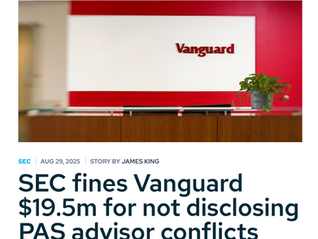- Rubin Miller, CFA

- May 20, 2023
- 5 min read
Passive investing leads to better expected investor outcomes, but index funds are suboptimal.
There's no need to outsource your portfolio to an arbitrary third-party list. Instead, imbue the wisdom of an indexer's philosophy into a more thoughtful design and implementation process.
🍷 🍕 🍝
Bounjorno! We are living (and I'm working) in a rented apartment in Florence, Italy, for the next month. The view from my desk...is not terrible.

It's my first time in the country, and the eating/drinking/shopping/museum suggestions have poured in from friends. You won't believe the culture, they've kept saying.
My preferred definition of "culture" is from my friend Craig Wortmann, who runs Northwestern University's Kellogg Sales Institute, and whose work examines empirical research on improving sales organizations. Despite his expertise relating to workplaces, the definition fits broadly:
Culture is the way things get done around here.
At first it seems an almost elementary definition, like a starting point that needs revision. But you could spend hours workshopping this only to end up back at it, finally embracing the flexibility. It broadly empowers the entity (businesses, places, teams, etc...), which claim unique culture, to describe a differentiated description, carte blanche.
How do things get done around here? It's perfect.
Noteworthy cultures are generally persistent. Italy doesn't gap up for a few years and deliver crap food or shoddy museums. Neither Ibiza nor Las Vegas are known for their libraries. New Yorkers don't occasionally believe that anywhere else makes a decent bagel.
But with globalization, companies with viable products open up a world of possibilities (and billions of potential customers) by selling internationally. Brands like Samsung, Toyota, Adidas, Subaru, Louis-Vuitton, Chanel, IKEA, etc...none of which are headquartered in the U.S., all have big footprints there.
When corporations expand to rely on a global customer base, their economic outcomes look more like broad global economic outcomes, and less like their own country's unique economic outcomes.
Their success is no longer tied to the belly of culture back home. This is problematic for portfolio diversification.
Subaru, headquartered in Tokyo, cares about sales in Oregon and Colorado. Louis-Vuitton (Paris) and Chanel (London) care about sales in Miami and Los Angeles. What non-Swede hasn't had Jimmy McNulty's classic IKEA experience?
If the goal of global diversification is to get exposure to the economic engines in distinct parts of the world, we need to care less about where a company's headquarters are, and more about where they do business.
Here are three truths about portfolio diversification that can help investors arrive at an optimal portfolio design strategy:
1. Smooth investment returns beat chunky investment returns.
If you have $100 and then lose 20% (➡️ $80), and then gain 20% right back (➡️ $96), you lose $4 overall — despite that the arithmetic average return was $0.
If you have $100 and then lose 10% (➡️ $90), and then gain 10% right back (➡️ $99), you only lose $1 overall — with the same 0% arithmetic average return.
Volatility does more than just rattle investors...it's literally worse for your wealth.
The math is the same if you gain first and then lose...doesn't matter.
All else equal, outcomes are improved by smoother, low-volatility returns.
2. Multiple investments that have the same expected returns, but aren't perfectly correlated, can smoothen returns.
Splitting a portfolio across four countries instead of one (or 10 stocks, instead of three), is an example.
As a portfolio moves up and down, these not-perfectly-correlated sources of return should generate lower highs and higher lows, overall (i.e. a narrower distribution of outcomes). Less volatility and smoother returns.

3. All countries generally have the same expected return and are not perfectly correlated.
This does not mean all countries have the same political, business or economic backdrops; it means that once a company goes public (issues stock), the stock price will reflect the relevant political, business, and economic backdrop.
Countries with low corruption and business-friendly environments will (and do) have high relative prices, while high corruption and business-unfriendly countries will (and do) have lower relative prices.
This pricing mechanism allows investors to be indifferent between countries.
Quick example: if you divide the price of companies in the S&P 500 (i.e. large, U.S. companies) by the amount of money these companies earn each year, the average Price/Earnings ratio is currently ~ 23.
Therefore a company earning $10M per year might be valued at $230M overall.
The "value" is the price investors must pay for the company. Whether you buy $100 of the stock, or buy the whole damn company, your ownership has a relative price (to earnings) of 23.
The same ratio in Turkey's stock market is currently ~ 5. A Turkish company earning $10M per year on average would be valued at $50M.
This is somewhat simplified, but to bring the idea home — Turkish stocks are more than 4x cheaper than U.S. stocks.
Investors should resist the temptation to assume one country is better than the other, and instead acknowledge that there is information in relevant ratios that reflects aggregate investor opinions about the business, economic, and political backdrop for corporations in various countries.
Investors require lower prices to be willing to buy Turkish stocks over U.S. stocks, just as a consumer might require a lower price for buying a taco versus a pizza. The price has to clear for the purchase, and so it reflects value.
Don't let recency or familiarity bias vex your portfolio. The market has no memory, doesn't know where you live, nor what you know about.
There are reasons things are cheap, and reasons things are expensive, and this pricing equilibrium makes future country returns random.

If we want passive portfolios, and we can agree that smooth returns are good, that we can achieve them through owning multiple, not-perfectly correlated investments, and that we can't forecast which countries will do better than others in the future...then we have arrived at our ideal portfolio design:
We want to own nearly every stock in nearly every country, and especially ensure that we own companies without global footprints.
We want exposure to local economies that may uniquely zig when the world broadly zags. We want culture.

Index funds can't access culture very easily. Index lists need to be trackable, and tiny companies that actually reflect local economies aren't easily tracked. They're typically illiquid and small, and so it takes patient trading, nimbleness, and thoughtfully managing implementation tradeoffs to buy and sell these stocks effectively.
Thankfully, there are investment companies that offer passive funds but without the rigidity of tracking a third-party list.
Make sure you're subscribed to the blog to receive Against Index Funds, Part II next week — we'll discuss the stocks of Banca Monte dei Paschi di Siena (the oldest bank in the world), and Centrale del Latte della Toscana (an Italian dairy refiner/distributor), Ferrari, etc...to continue our conversation on how investors can actually pursue effective global diversification in their portfolio (and why index funds aren't the best tool do it).
Alla prossima!








